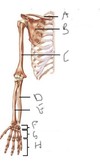2. Skeletal System Flashcards
Supine
Lying face up
Prone
Lying face down
Medial
Nearer to the midline
Lateral
Away from the midline
Bilateral
Both sides
Unilateral
One side
Ipsilateral
On the same side
Contralateral
On the opposite side
Proximal
Nearer to the trunk
Distal
Further from the trunk
Anterior ( ventral)
Nearer the front
Posterior (dorsal)
Nearer the back
Superior
Towards the top
Inferior
Towards the bottom
Coronal / frontal plane
Separating the front and back
Sagittal plane
Separating the left and right
Horizontal / transverse plane
Separating the top and bottom
How many bones in the human body?
206
What percentage of body weight is the skeleton?
18%
Functions of the skeleton
• Support framework for the body. • Forms boundaries(skull). • Attachment for muscles and tendons. • Permits movement(joints). • Haematopoiesis-formation and development of blood cells from the red bone marrow. • Mineral homeostasis (mostly calcium & phosphate). •Triglyceride storage(yellow bone marrow).
Bones Cells
- Osteogenic cells: 2. Osteoblasts: 3. Osteocytes: 4. Osteoclasts:
Osteogenic Cells
Bone stem cells. They are the only bone cell to undergo division (producing osteoblasts).
Osteoblasts
•These are bone building cells. •They synthesise and secrete collagen and other components of bony matrix. •They are trapped and become osteocytes.
Osteocytes
•Osteocytes are mature bone cells.They maintain the daily metabolism of bone, such as nutrient exchange.






